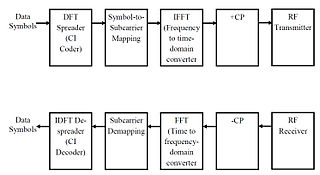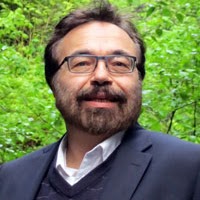Related Research Articles

In telecommunications, orthogonal frequency-division multiplexing (OFDM) is a type of digital transmission used in digital modulation for encoding digital (binary) data on multiple carrier frequencies. OFDM has developed into a popular scheme for wideband digital communication, used in applications such as digital television and audio broadcasting, DSL internet access, wireless networks, power line networks, and 4G/5G mobile communications.

In wireless communications, fading is variation of the attenuation of a signal with the various variables. These variables include time, geographical position, and radio frequency. Fading is often modeled as a random process. A fading channel is a communication channel that experiences fading. In wireless systems, fading may either be due to multipath propagation, referred to as multipath-induced fading, weather, or shadowing from obstacles affecting the wave propagation, sometimes referred to as shadow fading.

A single-frequency network or SFN is a broadcast network where several transmitters simultaneously send the same signal over the same frequency channel.

A space–time code (STC) is a method employed to improve the reliability of data transmission in wireless communication systems using multiple transmit antennas. STCs rely on transmitting multiple, redundant copies of a data stream to the receiver in the hope that at least some of them may survive the physical path between transmission and reception in a good enough state to allow reliable decoding.

Orthogonal frequency-division multiple access (OFDMA) is a multi-user version of the popular orthogonal frequency-division multiplexing (OFDM) digital modulation scheme. Multiple access is achieved in OFDMA by assigning subsets of subcarriers to individual users. This allows simultaneous low-data-rate transmission from several users.
CDD may refer to:
IEEE 1901 is a standard for high-speed communication devices via electric power lines, often called broadband over power lines (BPL). The standard uses transmission frequencies below 100 MHz. This standard is usable by all classes of BPL devices, including BPL devices used for the connection to Internet access services as well as BPL devices used within buildings for local area networks, smart energy applications, transportation platforms (vehicle), and other data distribution applications.
Multi-carrier code-division multiple access (MC-CDMA) is a multiple access scheme used in OFDM-based telecommunication systems, allowing the system to support multiple users at the same time over same frequency band.
In telecommunications, a diversity scheme refers to a method for improving the reliability of a message signal by using two or more communication channels with different characteristics. Diversity is mainly used in radio communication and is a common technique for combatting fading and co-channel interference and avoiding error bursts. It is based on the fact that individual channels experience fades and interference at different, random times, i.e., they are at least partly independent. Multiple versions of the same signal may be transmitted and/or received and combined in the receiver. Alternatively, a redundant forward error correction code may be added and different parts of the message transmitted over different channels. Diversity techniques may exploit the multipath propagation, resulting in a diversity gain, often measured in decibels.
Single-carrier FDMA (SC-FDMA) is a frequency-division multiple access scheme. Originally known as Carrier Interferometry, it is also called linearly precoded OFDMA (LP-OFDMA). Like other multiple access schemes, it deals with the assignment of multiple users to a shared communication resource. SC-FDMA can be interpreted as a linearly precoded OFDMA scheme, in the sense that it has an additional DFT processing step preceding the conventional OFDMA processing.

Carrier Interferometry(CI) is a spread spectrum scheme designed to be used in an Orthogonal Frequency-Division Multiplexing (OFDM) communication system for multiplexing and multiple access, enabling the system to support multiple users at the same time over the same frequency band.

WiMAX MIMO refers to the use of Multiple-input multiple-output communications (MIMO) technology on WiMAX, which is the technology brand name for the implementation of the standard IEEE 802.16.

In radio, multiple-input and multiple-output (MIMO) is a method for multiplying the capacity of a radio link using multiple transmission and receiving antennas to exploit multipath propagation. MIMO has become an essential element of wireless communication standards including IEEE 802.11n, IEEE 802.11ac, HSPA+ (3G), WiMAX, and Long Term Evolution (LTE). More recently, MIMO has been applied to power-line communication for three-wire installations as part of the ITU G.hn standard and of the HomePlug AV2 specification.

Underwater acoustic communication is a technique of sending and receiving messages in water. There are several ways of employing such communication but the most common is by using hydrophones. Underwater communication is difficult due to factors such as multi-path propagation, time variations of the channel, small available bandwidth and strong signal attenuation, especially over long ranges. Compared to terrestrial communication, underwater communication has low data rates because it uses acoustic waves instead of electromagnetic waves.

Georgios B. Giannakis is a Greek-American Computer Scientist, engineer and inventor. He has been an Endowed Chair Professor of Wireless Telecommunications, he was Director of the Digital Technology Center, and at present he is a McKnight Presidential Chair with the Department of Electrical and Computer Engineering at the University of Minnesota.
The first smart antennas were developed for military communications and intelligence gathering. The growth of cellular telephone in the 1980s attracted interest in commercial applications. The upgrade to digital radio technology in the mobile phone, indoor wireless network, and satellite broadcasting industries created new opportunities for smart antennas in the 1990s, culminating in the development of the MIMO technology used in 4G wireless networks.
Multiple-input, multiple-output orthogonal frequency-division multiplexing (MIMO-OFDM) is the dominant air interface for 4G and 5G broadband wireless communications. It combines multiple-input, multiple-output (MIMO) technology, which multiplies capacity by transmitting different signals over multiple antennas, and orthogonal frequency-division multiplexing (OFDM), which divides a radio channel into a large number of closely spaced subchannels to provide more reliable communications at high speeds. Research conducted during the mid-1990s showed that while MIMO can be used with other popular air interfaces such as time-division multiple access (TDMA) and code-division multiple access (CDMA), the combination of MIMO and OFDM is most practical at higher data rates.
Non-orthogonal frequency-division multiplexing (N-OFDM) is a method of encoding digital data on multiple carrier frequencies with non-orthogonal intervals between frequency of sub-carriers. N-OFDM signals can be used in communication and radar systems.
Orthogonal Time Frequency Space (OTFS) is a 2D modulation technique that transforms the information carried in the Delay-Doppler coordinate system. The information is transformed in the similar time-frequency domain as utilized by the traditional schemes of modulation such as TDMA, CDMA, and OFDM. It was first used for fixed wireless, and is now a contending waveform for 6G technology due to its robustness in high-speed vehicular scenarios.
Maryline Hélard is a French research engineer specializing in wireless networks. Her research interests include wired and wireless communications and multiple-input multiple-output (MIMO) techniques.
References
- Louay M.A. Jalloul and Sam. P. Alex, "Evaluation Methodology and Performance of an IEEE 802.16e System", Presented to the IEEE Communications and Signal Processing Society, Orange County Joint Chapter (ComSig), December 7, 2006. Available at: https://web.archive.org/web/20110414143801/http://chapters.comsoc.org/comsig/meet.html
- A. Dammann and S. Kaiser. Performance of low complex antenna diversity techniques for mobile OFDM systems. In Proceedings 3rd International Workshop on Multi-Carrier Spread-Spectrum & Related Topics (MC-SS 2001), Oberpfaffenhofen, Germany, pages 53–64, Sept. 2001. ISBN 0-7923-7653-6.
- P. Larsson, US-6842487 B1, WO/2002/025857, "Cyclic Delay Diversity for Mitigating ISI in OFDM systems", filed 22 September 2000 First filed patent application Archived 2016-03-07 at the Wayback Machine , PCT Biblio. data from WIPO.